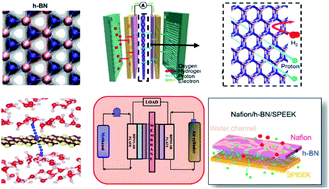Proton conductivity of a hexagonal boron nitride membrane and its energy applications
Abstract
Hexagonal boron nitride (h-BN) is a promising material for membrane applications due to its high chemical stability in the presence of solvents, outstanding mechanical strength, and high thermal stability. Theoretically, h-BN has very small pores (approximately 3.0 Å2) at the centers of hexagonal rings formed by the different electron cloud densities of B and N atoms. Through the centers of these rings, h-BN allows protons to pass while bigger ions are blocked. It has been demonstrated that h-BN exhibits good proton conductivity (approximately 100 mS cm−1) and a separation factor (approximately 10) for protons and deuterons. Furthermore, the van der Waals gaps between layers of 2D materials can be utilized as channels to allow protons to pass while blocking bigger ions. For real-world applications, such as fuel cells or batteries, large-scale h-BN has been applied and exhibited good performance. In this review, we introduce preparation methods for h-BN, theoretical calculations of the proton conductivity of h-BN, and real-world applications of h-BN membranes. Finally, we provide additional perspectives regarding h-BN membranes.



 Please wait while we load your content...
Please wait while we load your content...